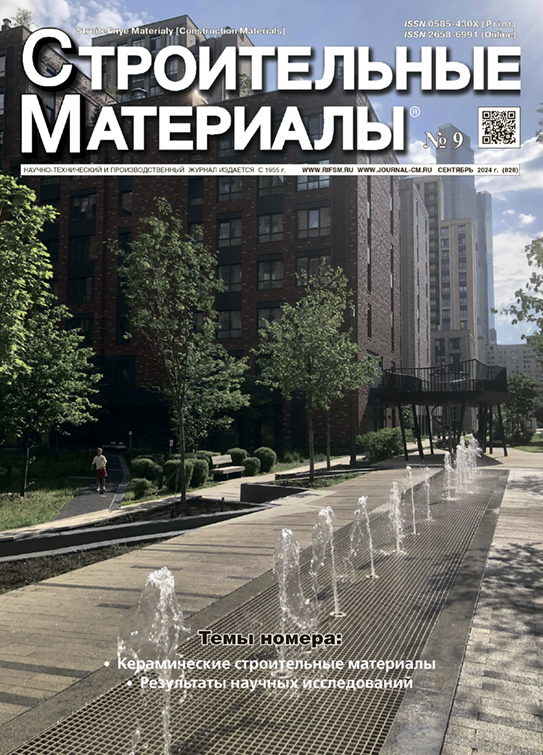Конкурентные позиции силикатного кирпича на отечественном рынке: угрозы и возможности для производителей
- Авторы: Акулова И.И.1, Славчева Г.С.2, Бабенко Д.С.2
-
Учреждения:
- Воронежский государственный технический университет
- Воронежский государственный технический университет
- Выпуск: № 9 (2024)
- Страницы: 44-50
- Раздел: Статьи
- URL: https://rjonco.com/0585-430X/article/view/636797
- DOI: https://doi.org/10.31659/0585-430X-2024-828-9-44-50
- ID: 636797
Цитировать
Полный текст
Аннотация
Обсуждается проблема оценки перспектив силикатного кирпича на отечественном рынке мелкоштучных стеновых материалов. Решение данной проблемы опирается на результаты анализа рыночной ситуации, потребительских предпочтений и конкурентоспособности силикатного кирпича. Показано, что в период с 2014 по 2021 г. ввиду более «сильных» конкурентных позиций блоков из автоклавного ячеистого бетона и лицевого керамического кирпича сократилась емкость рынка силикатного кирпича, снизились объемы его производства и доля в структуре потребления мелкоштучных стеновых материалов. Представлены результаты маркетинговых исследований, проведенных на основе онлайн-анкетирования респондентов, в соответствии с которыми большинство опрошенных считают лицевой керамический кирпич материалом, в наибольшей степени отвечающим их требованиям по качеству и внешнему виду. Расчеты показали, что, несмотря на практически равные по сравнению с керамическим кирпичом позиции по техническим параметрам и худшие – по эстетическим, наиболее конкурентоспособным является, тем не менее силикатный кирпич, обладающий относительно невысокой ценой. В ряду угроз для производителей силикатного кирпича обозначены снижение спроса на продукцию, высокая степень износа технологического оборудования, зависимость от зарубежных поставок пигментов, запчастей и комплектующих для оборудования, недостаточный уровень профессиональных компетенций персонала и др. Предполагается, что в перспективе рядовой силикатный кирпич, по-видимому, уйдет со строительного рыка, в связи с чем производителям предстоит сосредоточиться на совершенствовании качества и эстетических параметров лицевого силикатного кирпича при поддержании привлекательной для потребителей цены.
Ключевые слова
Полный текст
Об авторах
И. И. Акулова
Воронежский государственный технический университет
Автор, ответственный за переписку.
Email: akulovaii@yandex.ru
д-р экон. наук
Россия, 394006, г. Воронеж, ул. 20-летия Октября, 84Г. С. Славчева
Воронежский государственный технический университет
Email: gslavcheva@yandex.ru
д-р техн. наук
Россия, 394006, г. Воронеж, ул. 20-летия Октября, 84Д. С. Бабенко
Воронежский государственный технический университет
Email: babenko.dmitrii@bk.ru
инженер-исследователь
Россия, 394006, г. Воронеж, ул. 20-летия Октября, 84Список литературы
- Семёнов А.А. Итоги развития российского рынка стеновых материалов в 2021 г. // Строительные материалы. 2022. № 3. С. 44–45. https:// doi.org/10.31659/0585-430X-2022-800-3-44-45
- Гомонко Э.А., Хрючкина Е.А., Поливкина Д.Л. Современное состояние и перспективы развития российского рынка строительных материалов // Вестник Белгородского университета кооперации, экономики и права. 2020. № 4 (83). С. 228–244.
- Ананьев А.И., Рымаров А.Г., Титков Д.Г. Тепло-технические свойства и долговечность наружных облицовочных слоев кирпичных стен зданий // Промышленное и гражданское строительство. 2021. № 7. С. 22 –30. https://doi.org/10.33622/0869-7019.2021.07.22-30
- Семёнов А.А. Силикатный кирпич и газосиликат. Некоторые тенденции рынка в 2018–2019 гг. // Строительные материалы. 2019. № 8. С. 3–5. https://doi.org/10.31659/0585-430X-2019-773-8-3-5
- Семёнов А.А. Российский рынок керамического кирпича. Тенденции и перспективы развития // Строительные материалы. 2020. № 12. С. 4–5. https://doi.org/10.31659/0585-430X-2020-787-12-4-5
- Шелковникова Т.И., Баранов Е.В., Сазанов С.С. Анализ рынка и потребительских свойств керамического кирпича // Вестник Белгородского государственного технологического университета им. В.Г. Шухова. 2019. № 12. С. 8–16. https:// doi.org/10.34031/2071-7318-2019-4-12-8-16
- Акулова И.И. Исследование и учет потребительских предпочтений на рынке жилой недвижимости как основа формирования эффективной градостроительной политики // Жилищное строительство. 2017. № 4. С. 3–6.
- Азгальдов Г.Г., Костин А.В., Привень А.И., Смирнов В.В. Квалиметрия в измерении конкурентоспособности // Большой консалтинг. 2014. № 2. С. 22–25.
- Акулова И.И., Гончаров К.И., Хабаров К.В. Методический подход к оценке значимости факторов при прогнозировании развития экономических систем (на примере рынка жилья) // Жилищное строительство. 2021. № 12. С. 45–48. https://doi.org/10.31659/0044-4472-2021-12-45-50
- Аскаров Е.С. Выбор весовых коэффициентов при оценке качества продукции или услуги // Вестник Казахской академии транспорта и коммуникаций им. М. Тынышпаева. 2018. № 4 (107). С. 76–83.
- Овчаров А.В., Бабкина Т.В. Формирование комплексного подхода к оценке конкурентоспособности продукции промышленного предприятия // Креативная экономика. 2021. Т. 15. № 10. С. 3805–3822. https://doi.org/10.18334/ce.15.10.113698
- Akulova I.I., Slavcheva G.S. A new approach to identifying top priority step for increasing the building materials competitiveness. IOP Conference Series: Materials Science and Engineering. International Science and Technology Conference (FarEastCon 2020). 6–9 October 2020. Russky Island. Russia. 2021. 032030. https://doi.org/10.1088/1757-899X/1079/3/032030
- Славчева Г.С., Акулова И.И. Определение первоочередных направлений повышения качества и конкурентоспособности строительных материалов: методика и алгоритм // Строительные материалы. 2022. № 3. С. 56–60. https://doi.org/10.31659/0585-430X-2022-800-3-56-60
- Норенков С.В., Крашенинникова Е.С., Крашенинников А.В. Архитектор мыслит «кирпичным стилем», а производитель кирпича – кубатурой: о смягчении рисков взаимопонимания // Строительные материалы. 2019. № 12. С. 13–17. https:// doi.org/10.31659/0585-430X-2019-777-12-13-17
- Ананьев А.И., Рымаров А.Г., Титков Д.Г. Энергоэффективные здания с наружными кирпичными стенами без мягких утеплителей // Промышленное и гражданское строительство. 2023. № 10. С. 105–110. https://doi.org/10.33622/0869-7019.2023.10.105-110
Дополнительные файлы
















